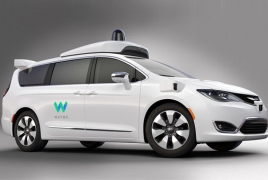Google’s new self-driving minivans hitting the road later this month January 9, 2017 - 12:13 AMT PanARMENIAN.Net - Waymo, the self-driving car startup spun-off from Google late last year, will be deploying its fleet of self-driving Chrysler Pacifica minivans onto public roads for the first time later this month, the company announced at the North American International Auto Show Sunday, January 8, The Verge reports. The minivans will be hitting the roads in Mountain View, California and Phoenix, Arizona, where the company’s self-driving Lexus SUVs have already driven thousands of miles over the past few years. Also Sunday, Waymo gave the public its first look at the self-driving Pacificas, which have been under wraps since the deal between Google and Fiat Chrysler was first announced back in May 2016. But here’s the thing about these minivans. Waymo says that for the first time, its producing all the technology that enables its cars to completely drive themselves in-house. That means for the first time, the Google spin-off is building all its own cameras, sensors, and mapping technology, rather than purchasing parts off the shelf as it had done in the past. This allows the company to exert more control over its self-driving hardware, as well as bring the cost down to ridiculously cheap levels. In a speech in Detroit, Waymo CEO John Krafcik said that by building its own LIDAR sensors, for example, the company was shaving 90 percent off its costs. That means sensors that Google purchased for $75,000 back in 2009 now only cost $7,500 for Waymo to build itself. To be sure, the cost of high-end LIDAR sensors have dropped precipitously over the years. Velodyne, a top supplier of LIDAR, retails its sensors for $7,999. But by building its own (or contracting out the manufacturing), Waymo is able to get LIDAR sensors to its exact specifications. For instance, Krafcik said the company developed two new types of LIDAR: short range and long range, allowing its vehicles to see people and objects very close to the car, as well as spot tiny objects far away. That said, Waymo has no interest in becoming an auto parts supplier like Delphi or 3M. Rather its focus is on forging partnerships with OEMs (original equipment manufacturers) like Chrysler and Honda to purchase fleets of vehicles or retrofit for self-driving capabilities. Rumor has it that Waymo and Chrysler will eventually launch their own autonomous ride-sharing service to compete with the likes of Uber and Lyft, possibly by utilizing Google’s Waze mapping service. Indeed, during his remarks in Detroit, Krafcik said Waymo was eyeing a number of products, including ride-hailing, logistics, personal transportation, and last-mile solutions. When it spun off Waymo in early December, Google essentially conceded that it was dropping its plan to build its own car, instead refocusing its efforts on making the hardware and software needed to power self-driving. It may be too soon to say that Google is abandoning its plans to build a fleet of driverless cars without steering wheels and pedals. Previously, Krafcik made it clear that Waymo “is not a car company, there’s been some confusion on that point. We’re not in business of making better cars, we’re in the business of making better drivers.” Yerevan will host the 2024 edition of the World Congress On Information Technology (WCIT). Rustam Badasyan said due to the lack of such regulation, the state budget is deprived of VAT revenues. Krisp’s smart noise suppression tech silences ambient sounds and isolates your voice for calls. Gurgen Khachatryan claimed that the "illegalities have been taking place in 2020." Partner news |